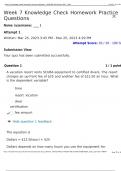Computer Packages 1
WEEK 1
Concepts of Information Technology (IT)
Information Technology (IT)
• A general term that relates to the use of computers as an aid to creating and maintaining data, i.e.
information. IT is related to all aspects of managing and processing information, especially within a
large organization. Computers are critical to managing information, and computer departments
within large organizations are often called IT departments. Alternative phrases are IS departments
(Information Services) or MIS departments (Management Information Services). People working
with computers within large companies will often refer to their job, as “working in IT”.
Hardware
• The term hardware refers to the physical components of your computer such as the system unit,
mouse, keyboard, monitor etc.
Software
• The software is the collection of instructions that makes the computer work. For instance, when
you type in words via the keyboard, the software is responsible for displaying the correct letters, in
the correct place on the screen. Software is held either on your computer’s hard disk, CD-ROM,
DVD or on a diskette (floppy disk) and is loaded (i.e. copied) from the disk into the computers
RAM (Random Access Memory), as and when required.
Types of Computer
What is a mainframe computer?
• Mainframe computers are the big, powerful, expensive computers used in the background by most
large organizations. The power of the mainframe can be distributed amongst many people
accessing the mainframe via their own PC. Organizations such as large insurance companies
would use the mainframe to keep track of their policyholders and send out renewal notices.
What is a PC?
• IBM invented the PC (Personal Computer) way back in 1981. All PCs released since then are in
many ways compatible with the original design, though many extensions have been made. The
term PC compatible relates to PCs manufactured by companies other than IBM that are
compatible with the traditional PC specification. In the early days, most PCs ran an operating
system called DOS (Disk Operating System). These days most PCs will be running a version of
Microsoft Windows.
What are laptop & palmtop computers?
• Laptop computers, as the name implies, are small portable computers that can run on batteries as
well as mains power. They use special screens, rather than the traditional bulky VDUs (Visual
Display Units), which allows for longer battery life as well as portability. A newer term,
“Notebooks”, simply indicates a VERY small laptop. These are especially popular with
salespersons on the move or people giving presentations. While they tend to still be more
expensive than an equivalent Desktop computer, they can now match the power of a Desktop
computer. Palmtops are even smaller computers that can literally fit into the palm of your hand.
What is a Personal Digital Assistant (PDA)?
• These devices use a special pen, rather than a keyboard and can be used for storing and
retrieving information. Like most computer devices, many can connect to the Internet. They are
extremely compact.
Page 1 of 58
, Students training Manual
Computer Packages 1
WEEK 2
Main Parts of a Personal Computer
The System Unit
• The "system unit" is the name given to the main PC box that houses the various elements that go
together to make up the PC. For instance within the system unit is the computer system's
motherboard, which contains all the main components, such as the CPU. The system unit also
houses items such as the hard disk, the floppy disk and CD-ROM drives etc. System units come in
two basic varieties, the tower version, as illustrated, or a desktop version, which is designed to sit
on your desk with your monitor on top of the system unit.
The System (Mother) Board
• The system (mother) board in contained within your system unit and all the vital computer systems
plug directly into the system board. The CPU is normally housed on your system board along with
all the other electronic components. Other items such as the hard disk are attached to the system
board, either directly or via cables. These boards are getting smaller and smaller as the
components become more integrated. If you open up a modern system you will find that it is
mainly full of air.
The CPU (Central Processing Unit)
• The CPU is the brains within your computer. It performs most of the calculations within the
computer and is responsible for the smooth running of your operating system (Microsoft Windows)
as well as your application programs, such as word-processors, spreadsheets and databases.
There is a small amount of memory associated with the CPU, which it uses to perform these
operations. It also accesses and uses the main memory (RAM - Random Access Memory) within
your computer. In many ways, the CPU is the single most important item within your computer that
governs the overall speed of your computer. The CPU's speed is measured in MHz. This relates to
the frequency that the CPU runs at and the higher the MHz rating of your CPU the faster your
computer will run. To give you some indication of how PCs have advanced over the years, the
original IBM PC released in 1981 ran at less than 5 MHz while modern PCs can run at speeds well
in excess of 2000 MHz. Note that 1000 MHz is the same a 1 GHz.
Memory RAM
Random Access Memory (RAM) is the main 'working' memory used by the computer. When
the operating system loads from disk when you first switch on the computer, it is copied into
Page 2 of 58











